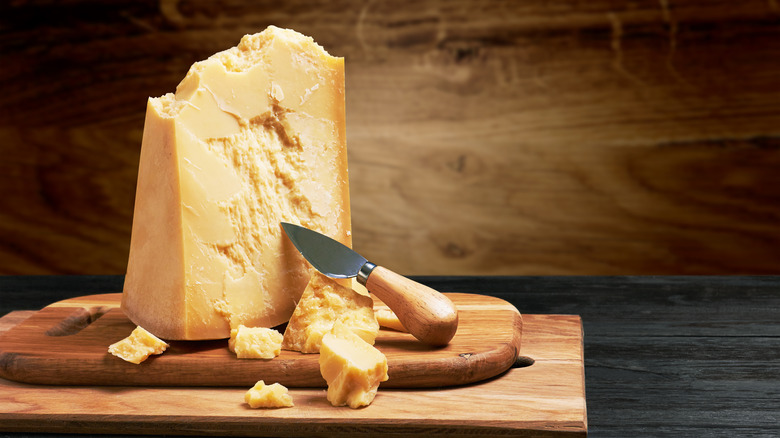Here's The Difference Between Eggs In Purgatory And Shakshuka
Prepare your taste buds for a journey through the vibrant and flavorful world of egg-centric dishes, starting with eggs in purgatory and shakshuka. These two iconic egg dishes share a common heritage rooted in Mediterranean and Middle Eastern cuisines but boast distinct flavors and ingredients that set them apart. Eggs in purgatory, also known as uova al purgatorio in Italian, features eggs gently poached in a fiery tomato sauce infused with garlic, chili flakes, and herbs. This Italian classic is typically served with crusty bread for soaking up the savory sauce.
In contrast, shakshuka, a beloved staple of North African and Middle Eastern cuisine, features eggs poached in a rich tomato and pepper sauce seasoned with aromatic spices that are local to the region. Often served with crumbled feta cheese and fresh herbs such as cilantro, parsley, and even mint, shakshuka offers a more complex and robust flavor profile compared to its Italian counterpart. While both dishes offer a satisfyingly spicy and savory culinary experience, their distinct ingredients and flavor profiles showcase the rich diversity of egg-based dishes found around the globe.
What is shakshuka?
At its core, shakshuka is an easy-to-make dish that features eggs poached in a luscious and aromatic tomato and pepper sauce infused with a medley of spices and herbs. Key ingredients typically include fresh and canned tomatoes, bell peppers, onions, garlic, and a fragrant blend of spices such as cumin, paprika, and cayenne pepper. The dish is often garnished with fresh herbs like cilantro or parsley and served with flatbread or pita for dipping and sopping up the flavorful sauce.
Shakshuka's origins are steeped in centuries-old culinary traditions, with variations of the dish found across North Africa and the Middle East. Some sources trace its roots to Ottoman cuisine, while others attribute its creation to Moroccan or Tunisian kitchens. Regardless of its exact origins, shakshuka has evolved into a beloved staple of home cooking and restaurant menus alike, cherished for its bold flavors, comforting warmth, and versatile nature
What are eggs in purgatory?
Eggs in purgatory is a similar dish that features eggs gently poached in a spicy tomato sauce, seasoned with garlic, chili flakes, and fragrant herbs like basil or oregano. Additional key ingredients typically include ripe tomatoes, olive oil, garlic, and eggs along with a generous sprinkling of Parmesan cheese and crusty bread for serving.
The dish's origins trace back to southern Italy, where it was traditionally enjoyed as a humble yet satisfying meal by farmers and laborers. The name "eggs in purgatory" is said to stem from the fiery heat of the spicy tomato sauce, which is believed to evoke the flames of purgatory in Italian folklore. Over the years, eggs in purgatory has evolved from a simple peasant dish into a beloved classic of Italian cuisine, cherished for its robust flavors, ease of preparation, and hearty satisfaction. No matter what occasion it is served at, eggs in purgatory offers a comforting taste of Italy's rich culinary heritage and continues to captivate diners with its rustic charm and delicious simplicity.
Shakshuka includes additional ingredients
One of the key distinctions between shakshuka and eggs in purgatory lies in their unique spice profiles, which reflect the culinary traditions of their respective regions. In shakshuka, the tomato base is infused with a vibrant array of spices, including cumin, paprika, and cayenne pepper. Additionally, shakshuka often incorporates bell peppers and chili peppers, such as jalapeños or serranos, to further enhance the dish's depth of flavor and add a subtle heat. These spices and peppers lend shakshuka its characteristic complexity and warmth, making it a beloved favorite among fans of Middle Eastern and North African cuisine.
Conversely, eggs in purgatory, with its Italian roots, features a simpler spice profile that typically relies on garlic, basil, oregano, and red pepper flakes for flavor. While eggs in purgatory incorporates red pepper flakes for a touch of heat, it also sometimes includes anchovies for added depth and umami richness, reflecting its Mediterranean origins. These subtle differences in spice and seasoning contribute to the distinct identities of shakshuka and eggs in purgatory.
Eggs in purgatory calls for parmesan
The choice of cheese in shakshuka and eggs in purgatory adds a distinct layer of flavor and texture to each dish. In eggs in purgatory, parmesan cheese is often grated over the finished dish, imparting a rich and nutty flavor that complements the savory tomato sauce and adds a subtle umami depth. With its origins in Italy, parmesan brings a touch of Mediterranean elegance to the dish, echoing the simplicity and sophistication of Italian cuisine.
Shakshuka is traditionally garnished with crumbled feta cheese, which offers a tangy and salty contrast to the sweet and spicy tomato base. Feta, a staple of Greek and Middle Eastern cuisine, infuses shakshuka with a briny richness that enhances its bold flavors and adds a creamy texture. The use of parmesan in eggs in purgatory and feta in shakshuka not only highlights the regional origins of each dish but also showcases the diverse and complementary flavors of Mediterranean and Middle Eastern cheeses. Whether it's the sharp bite of parmesan or the creamy tang of feta, the choice of cheese plays a crucial role in elevating the flavor profiles of these beloved tomato-based egg dishes.
Serve shakshuka with flatbread
When it comes to serving shakshuka and eggs in purgatory, the choice of bread reflects the culinary traditions of their respective regions. Shakshuka is typically accompanied by naan, pita, or challah — breads that are well-suited for scooping up the flavorful tomato sauce and creamy eggs. These breads provide the perfect canvas for savoring the bold and aromatic flavors of the dish. Eggs in purgatory is often served with crusty bread such as baguette, which offers a satisfying crunch and sturdy texture that pairs beautifully with the rich tomato sauce and tender poached eggs.
Despite their differences, both dishes share a common thread of comfort and warmth, with their subtle complexities and nuanced flavors setting them apart from one another. While shakshuka delights with its spicy and aromatic tomato base, eggs in purgatory enchants with its savory and herbaceous notes, showcasing the rich tapestry of Mediterranean and Middle Eastern cuisine. Whether enjoyed for breakfast or for dinner as Ina Garten sometimes does, these tomato-based egg dishes offer a tantalizing taste of culinary traditions from around the globe.





